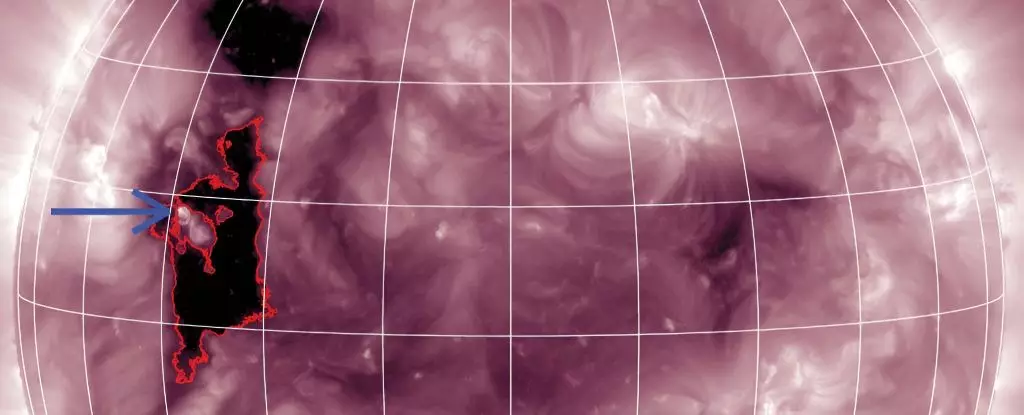The cosmos is a realm of wonders, yet the recent discovery concerning an abundant release of helium-3 from a gaping hole in the Sun’s atmosphere has illuminated just how much we still have to learn about our closest star. Observations conducted in late October 2023 revealed an extraordinary event—helium-3 emissions were recorded at levels unprecedented in the Solar System’s history. This revelation not only draws a connection between solar phenomena and cosmic chemistry but also invites a profound reconsideration of our understanding of the processes at play within the Sun.
Astrophysicist Radoslav Bučík from the Southwest Research Institute articulated the rarity of helium-3, stating it is found at an astonishingly low ratio of one part helium-3 for every 2,500 parts helium-4. The implications of this lack of abundance ring vividly; the universe’s history is partially captured within these isotopes, with most elements believed to have emerged from the primordial aftermath of the Big Bang. Yet, our star’s recent belching of helium-3 presents both a scientific puzzle and an exhilarating opportunity to delve deeper into the heliospheric mysteries.
The Phenomenon of Coronal Holes: Portals of High-Energy Particles
Central to this discovery is the coronal hole—a mysterious feature of the Sun that creates openings in the magnetic field. These areas allow solar wind to escape more readily, propelling charged particles into space with remarkable energy. The observed event unfolded on October 24 and 25, coinciding with an identifiable coronal hole and an exceptionally high concentration of helium-3—180,000 times the typical levels.
This magnitude of production suggests a tumultuous cosmic interaction where magnetic fields play an essential role. Interestingly, the solar jet that sourced this helium-3 was characterized by a departure from the expected magnetic intensity, being weaker than what would typically be seen in active regions. This deviation strengthens theories that posit helium-3 enrichment is more likely in plasma environments where turbulence is minimal, a counterintuitive insight that challenges existing paradigms.
The Exceptional Composition of Solar Events: A New Chapter in Understanding Solar Chemistry
Notably, the solar particle event of October 2023 showcased a remarkable composition that diverges from previous events. Historically, solar jets tend to be laden with heavier elements. However, this particular event saw strikingly low concentrations of iron alongside significant amounts of lighter elements such as carbon, nitrogen, silicon, and sulfur. Only 19 similar events have been cataloged since 1999, leading to an enticing conclusion: Either such unique events are a rare cosmic anomaly, or they are more commonplace and largely overlooked due to their subdued nature.
The unique outflow from the Sun during this event brings forth new questions about the behavior of solar jets, urging astronomers to reconsider their strategies for studying the solar atmosphere. The chance for increased insights into solar chemistry leads to exciting potential advancements not just for our understanding of the Sun but also the broader mechanisms that govern stellar formations across the universe. Solar Orbiter’s strategic positioning—approximately halfway between Earth and the Sun—offers an advantageous perspective, allowing this satellite to record nuanced details of solar activity that remain obscured from typical terrestrial observations.
Implications for Future Solar Research: Charting New Boundaries
As we stand on the precipice of a new era in solar research, the implications of helium-3 discoveries echo far beyond mere scientific interest. The ongoing investigation into coronal holes and the particle events they give rise to could transform our understanding of stellar mechanics. Potential applications extend into multiple domains, from enhancing our capability to predict solar weather that may impact Earth to fueling cutting-edge research into fusion energy, where helium-3 could serve as a clean energy source.
Moreover, understanding the processes that enable the Sun to exhibit such extraordinary behavior can deepen our appreciation for the subtle balances that characterize cosmic environments. The layered complexities of an event like the October 2023 helium-3 surge compel us to reconceptualize our relationship with the Sun, illustrating not merely a source of light and warmth, but a dynamic entity rife with unforeseen mysteries that compel us to probe deeper into the universe we inhabit.
As explorations into solar phenomena and cosmic chemistry unfold, the event serves as a reminder of the untamed features of our star and ignites an infectious curiosity to unearth more of what lies hidden amid the rays of the Sun. The pursuit of knowledge continues to promise not only thrilling discoveries but a more profound sense of our place in a vast and intricate universe.

